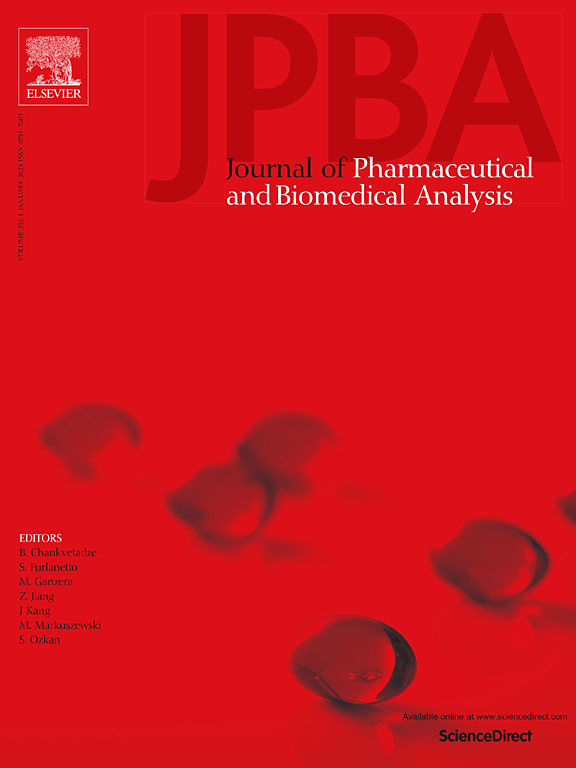Dual recombinase polymerase amplification system combined with lateral flow immunoassay for simultaneous detection of Staphylococcus aureus and Vibrio parahaemolyticus
IF 3.1
3区 医学
Q2 CHEMISTRY, ANALYTICAL
Journal of pharmaceutical and biomedical analysis
Pub Date : 2024-12-03
DOI:10.1016/j.jpba.2024.116621
引用次数: 0
Abstract
Development of a highly sensitive visualization platform for multiplex genetic detection could significantly improve efficiency and reliability of on-site detection of foodborne pathogens. In this study, coupling recombinase polymerase amplification (RPA) with lateral flow immunoassay (LFIA) readout system was proposed for Staphylococcus aureus and Vibrio parahaemolyticus detection. Taking the advantage of the isothermal amplification of RPA, dual primers modified with different labeling groups were designed to realize target signal amplification. LFIA coated with anti-digoxigenin antibody and streptavidin as test line 1 and 2 were designed to detect the two RPA products. The proposed method (dual RPA-LFIA) could realize visual detection using LFIA through rapid RPA amplification within 20 min, exhibiting a lowest detection limit of 4.6 × 102 CFU/mL for Staphylococcus aureus and Vibrio parahaemolyticus. The dual RPA-LFIA is characterized by simultaneous detection of dual targets in one RPA reaction and colorimetric readout through LFIA, thus ensuring high sensitivity and efficiency, and showing great potential to address the on-site detection of foodborne pathogens in the future.
双重组酶聚合酶扩增系统联合横向流动免疫分析法同时检测金黄色葡萄球菌和副溶血性弧菌。
开发高灵敏度的多重基因检测可视化平台,可显著提高食源性致病菌现场检测的效率和可靠性。本研究提出了重组酶聚合酶扩增(RPA)与侧流免疫分析(LFIA)读数系统耦合检测金黄色葡萄球菌和副溶血性弧菌的方法。利用RPA等温扩增的优势,设计了不同标记基团修饰的双引物,实现了目标信号扩增。以抗地高辛抗体和链霉亲和素包被的LFIA作为1号和2号测试线,检测两种RPA产物。该方法(双RPA-LFIA)可在20 min内通过快速RPA扩增实现LFIA目视检测,对金黄色葡萄球菌和副溶血性弧菌的最低检出限为4.6 × 102 CFU/mL。双RPA-LFIA的特点是在一个RPA反应中同时检测两个靶点,并通过LFIA进行比色读出,具有较高的灵敏度和效率,在解决未来食源性病原体的现场检测方面具有很大的潜力。
本文章由计算机程序翻译,如有差异,请以英文原文为准。
求助全文
约1分钟内获得全文
求助全文
来源期刊
CiteScore
6.70
自引率
5.90%
发文量
588
审稿时长
37 days
期刊介绍:
This journal is an international medium directed towards the needs of academic, clinical, government and industrial analysis by publishing original research reports and critical reviews on pharmaceutical and biomedical analysis. It covers the interdisciplinary aspects of analysis in the pharmaceutical, biomedical and clinical sciences, including developments in analytical methodology, instrumentation, computation and interpretation. Submissions on novel applications focusing on drug purity and stability studies, pharmacokinetics, therapeutic monitoring, metabolic profiling; drug-related aspects of analytical biochemistry and forensic toxicology; quality assurance in the pharmaceutical industry are also welcome.
Studies from areas of well established and poorly selective methods, such as UV-VIS spectrophotometry (including derivative and multi-wavelength measurements), basic electroanalytical (potentiometric, polarographic and voltammetric) methods, fluorimetry, flow-injection analysis, etc. are accepted for publication in exceptional cases only, if a unique and substantial advantage over presently known systems is demonstrated. The same applies to the assay of simple drug formulations by any kind of methods and the determination of drugs in biological samples based merely on spiked samples. Drug purity/stability studies should contain information on the structure elucidation of the impurities/degradants.

 求助内容:
求助内容: 应助结果提醒方式:
应助结果提醒方式:


